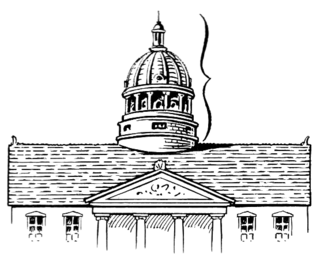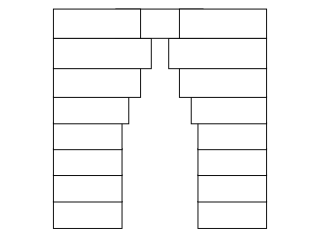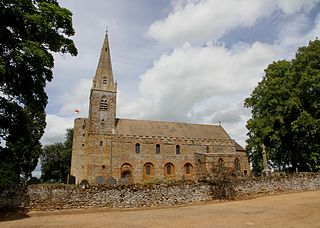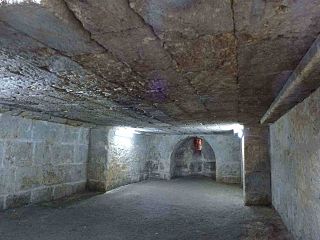
An arch is a curved vertical structure spanning an open space underneath it. Arch can either support the load above it or perform a purely decorative role. The arch dates back to fourth millennium BC, but became popular only after its adoption by the Romans in the 4th century BC.

A dome is an architectural element similar to the hollow upper half of a sphere. There is significant overlap with the term cupola, which may also refer to a dome or a structure on top of a dome. The precise definition of a dome has been a matter of controversy and there are a wide variety of forms and specialized terms to describe them.

Medieval architecture was the art of designing and constructing buildings in the Middle Ages. Major styles of the period include pre-Romanesque, Romanesque, and Gothic. The Renaissance marked the end of the medieval period, when architects began to favour classical forms. While most surviving medieval constructions are churches and military fortifications, examples of civic and domestic architecture can be found throughout Europe, including in manor houses, town halls, almshouses, bridges, and residential houses.

An arch bridge is a bridge with abutments at each end shaped as a curved arch. Arch bridges work by transferring the weight of the bridge and its loads partially into a horizontal thrust restrained by the abutments at either side. A viaduct may be made from a series of arches, although other more economical structures are typically used today.

Anglo-Saxon architecture was a period in the history of architecture in England from the mid-5th century until the Norman Conquest of 1066. Anglo-Saxon secular buildings in Britain were generally simple, constructed mainly using timber with thatch for roofing. No universally accepted example survives above ground. Generally preferring not to settle within the old Roman cities, the Anglo-Saxons built small towns near their centres of agriculture, at fords in rivers or sited to serve as ports. In each town, a main hall was in the centre, provided with a central hearth.

In architecture, a corbel is a structural piece of stone, wood or metal jutting from a wall to carry a superincumbent weight, a type of bracket. A corbel is a solid piece of material in the wall, whereas a console is a piece applied to the structure. A piece of timber projecting in the same way was called a "tassel" or a "bragger" in England.

Ashlar is a type of masonry that requires only a little mortar to bind it. The term can refer either to an individual stone that has been “finely dressed” until squared off, or to a structure built from such stones. Ashlar is the finest stone masonry unit, and is generally rectangular (cuboid). It was described by Vitruvius as opus isodomum or trapezoidal. Precisely cut "on all faces adjacent to those of other stones", ashlar is capable of requiring only very thin joints between blocks, and the visible face of the stone may be quarry-faced or feature a variety of treatments: tooled, smoothly polished or rendered with another material for decorative effect.

In architecture, a squinch is a triangular corner that supports the base of a dome. Its visual purpose is to translate a rectangle into an octagon. See also: pendentive.
This page is a glossary of architecture.

A corbel arch is an arch-like construction method that uses the architectural technique of corbeling to span a space or void in a structure, such as an entranceway in a wall or as the span of a bridge. A corbel vault uses this technique to support the superstructure of a building's roof.

All Saints' Church, Brixworth, now the parish church of Brixworth, Northamptonshire, England, is a leading example of early Anglo-Saxon architecture. It is the largest English church that remains substantially as it was in the Anglo-Saxon era. It was designated as a Grade I listed building in 1954.

A multifoil arch, also known as a cusped arch, polylobed arch, or scalloped arch, is an arch characterized by multiple circular arcs or leaf shapes that are cut into its interior profile or intrados. The term foil comes from the old French word for "leaf." A specific number of foils is indicated by a prefix: trefoil (three), quatrefoil (four), cinquefoil (five), sexfoil (six), octofoil (eight). The term multifoil or scalloped is specifically used for arches with more than five foils. The multifoil arch is characteristic of Islamic art and architecture; particularly in the Moorish architecture of al-Andalus and North Africa and in Mughal architecture of the Indian subcontinent. Variants of the multifoil arch, such as the trefoil arch, are also common in other architectural traditions such as Gothic architecture.

St Mary's Priory Church, Deerhurst, is the Church of England parish church of Deerhurst, Gloucestershire, England. Much of the church is Anglo-Saxon. It was built in the 8th century, when Deerhurst was part of the Anglo-Saxon kingdom of Mercia. It is contemporary with the Carolingian Renaissance on mainland Europe, which may have influenced it.

A jack arch is a structural element in masonry construction that provides support at openings in the masonry. Alternate names are lintel arch, flat arch and straight arch.

Muqarnas, also known in Iberian architecture as Mocárabe, is a form of ornamented vaulting in Islamic architecture. It is the archetypal form of Islamic architecture, integral to the vernacular of Islamic buildings. It was most likely first developed in eleventh-century Iraq, though the earliest preserved examples are also found outside this region.

Ablaq is an architectural technique involving alternating or fluctuating rows of light and dark stone. It is an Arabic term describing a technique associated with Islamic architecture in the Arab world. It may have its origins in earlier Byzantine architecture in the region, where alternating layers of white stone and orange brick were used in construction. The technique is used primarily for decorative effect.
A post is a main vertical or leaning support in a structure similar to a column or pillar, the term post generally refers to a timber but may be metal or stone. A stud in wooden or metal building construction is similar but lighter duty than a post and a strut may be similar to a stud or act as a brace. In the U.K. a strut may be very similar to a post but not carry a beam. In wood construction posts normally land on a sill, but in rare types of buildings the post may continue through to the foundation called an interrupted sill or into the ground called earthfast, post in ground, or posthole construction. A post is also a fundamental element in a fence. The terms "jack" and "cripple" are used with shortened studs and rafters but not posts, except in the specialized vocabulary of shoring.

Saxo-Norman is the very end of the Anglo-Saxon period in England and the start of the Norman occupation, typically between 1060 and 1100. Often used to refer to architecture and physical culture, the term addresses the combination of Anglo-Saxon and Norman styles prevalent during the period.

Domes first appeared in South Asia during medieval period when it was constructed with stone, brick and mortar, and iron dowels and cramps. Centering was made from timber and bamboo. The use of iron cramps to join together adjacent stones was known in Ancient India, and was used at the base of domes for hoop reinforcement. The synthesis of styles created by this introduction of new forms to the Hindu tradition of trabeate construction created a distinctive architecture.

Semicircular arch is an arch with intrados shaped like a semicircle. This type of arch was adopted and very widely used by the Romans, thus becoming permanently associated with the Roman architecture. When the arch construction involves the Roman techniques, it is known as a Roman arch. The semicircular arch is also known as a round arch.




















